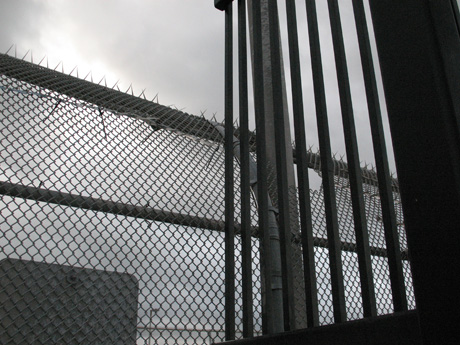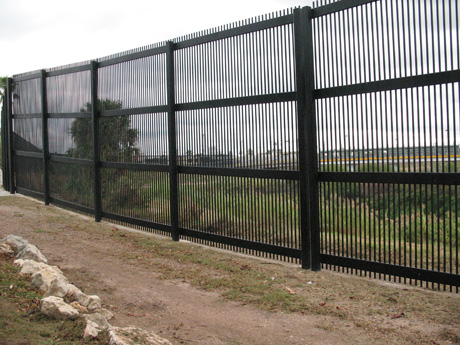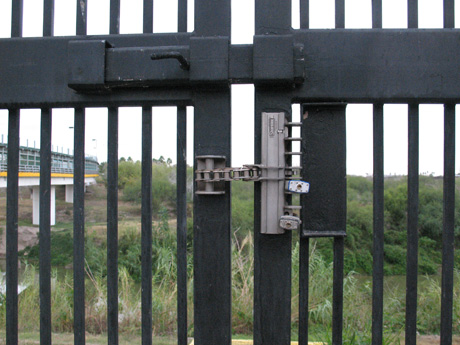RESPONSE TO "Tejano Monument Supporters Faced Questions," Austin American Statesman, March 28, 2012.
While it is important to challenge the Texas Creation Myth (Pioneer version) and its erasure of the historical, documented, and inherent relationship between Indigenous peoples and the land in Texas, (and the Tejano monument movement is a welcome interruption to the dominant project), it is also important that we challenge the rhetoric and discourses of "conquering history" (Antonia Castaneda) within the dominant construction of Tejano history. A rigorous engagement with multi-plural realities, multiple interest groups, the pattern of violent assimilation and the rise of a highly stratified (classed) society among Tejanos on the land needs close attention. The current-day memorialization of the Tejano experience offers an opportunity to re-think and re-examine South Texas' and the Texas-Mexico border peoples' histories with current-day lenses and tools. From an Indigenous lense, I wonder... in what ways did Indigenous peoples of mixed ancestry find it useful to build a coalitional land-based identity in resistance against Anglo-American cultivator-settlers? From an Indigenous view, the Tejano identity is an umbrella in which many Indigenous peoples with mixed ancestry have come underneath out from storms, and then left at different times in history.
Tejano identity has been fluid, not fixed, for Indigenous peoples undergoing violent displacements and being incorporated into labor pools for the elites.
It is important to look closely at the forces of assimilation among a very diverse Indigenous world along the Lower Rio Grande in the 18th, 19th, and 20th centuries, experiencing the crushing force of assimilation and criminalization by settlers--the most powerful interest group.
At different times, Tejano elites have worked alongside Indigenous resisters against Anglo-American settlement, and at other times Tejano elites built their identity and culture in competition to Anglo-American cultivators by the adoption of the oppressors' tools. Tejano elites are implicated in establishing their foothold on the land through the coerced and forced assimilation of Indigenous peoples.
We should ask: who gets to construct Tejano history today? Who specifically does the current version serve? Why is the Anglo-dominant political interest group offering concession to Tejanos now? What does this have to do with land development and partnerships related to oil, water, and uranium development in South Texas? And, most importantly, who does this model of public history leave out?
The Tejano monument is not really progressive or radical. Rather, it mimicks that which it purports to be challenging
Tejano identity has been fluid, not fixed, for Indigenous peoples undergoing violent displacements and being incorporated into labor pools for the elites.
It is important to look closely at the forces of assimilation among a very diverse Indigenous world along the Lower Rio Grande in the 18th, 19th, and 20th centuries, experiencing the crushing force of assimilation and criminalization by settlers--the most powerful interest group.
At different times, Tejano elites have worked alongside Indigenous resisters against Anglo-American settlement, and at other times Tejano elites built their identity and culture in competition to Anglo-American cultivators by the adoption of the oppressors' tools. Tejano elites are implicated in establishing their foothold on the land through the coerced and forced assimilation of Indigenous peoples.
We should ask: who gets to construct Tejano history today? Who specifically does the current version serve? Why is the Anglo-dominant political interest group offering concession to Tejanos now? What does this have to do with land development and partnerships related to oil, water, and uranium development in South Texas? And, most importantly, who does this model of public history leave out?
The Tejano monument is not really progressive or radical. Rather, it mimicks that which it purports to be challenging
True, the Tejano monument is a change that opens up a space in a very uniform field of historical interpretation which has, in Texas, been overly dominated (and thus, censored) by the White Anglo-Christian pioneer narrative.
On the other hand, the current construction of Tejano public history could take on more layers with a social justice lens that includes and educates about the realities of colonialism, genocide, gender violence, racism and a racially stratified society. This is the version that Indigenous peoples and peoples of mixed ancestry could recognize and see themselves within. This is the one which persists in Texas. At the center of a Tejano history with a social justice lense would be the central issue of land, dispossession, capitalism, and that peoples who identify as Tejanos --past and present-- have had a role in the dispossession and violent impoverishment of Indigenous peoples.
A critical human geography and critical race approach to public history could help to curb the trimmed down perspective of Tejano history that the more patriarchal, linear, and overly romantic (read: 'positive') versions tend to perpetuate. Not denying the reality of multiple Tejano histories, raced, classed, gendered, stratified: a Tejano-Tejana-Indigenous-European complex ancestry--that was and is a story of genocide denial--would be a truely valuable and humane contribution to contemporary Texas societies.
Further, a narrative that reflects the processes of Tejano history making--with a realistic representation of their role in colonization, and one contested by Indigenous peoples, past and present--would be a valued, cutting edge model of public history in a contemporary world.
Unfortunately, the Tejano monument the public is receiving, and the media discourses surrounding its birth, is not cutting edge. It is more of the same, in a multicultural model that is practicing covert racism and genocide against current-day Indigenous peoples who are the land owners muted in this neoliberal Tejano Creation Myth--without Indigenous peoples.
When powerful interest groups within the settler society continue to negate the existence and presence of Indigenous peoples, upon whose lands their success is made possible, then public history becomes an issue of human rights, the right of Indigenous peoples to challenge racist public education poliices, and an issue of the mental health of the Indigenous child, woman, man, family, and community. Ongoing denial of Indigenous presence and realities in Texas public history is a collective health crisis for Indigenous peoples.
A critical human geography and critical race approach to public history could help to curb the trimmed down perspective of Tejano history that the more patriarchal, linear, and overly romantic (read: 'positive') versions tend to perpetuate. Not denying the reality of multiple Tejano histories, raced, classed, gendered, stratified: a Tejano-Tejana-Indigenous-European complex ancestry--that was and is a story of genocide denial--would be a truely valuable and humane contribution to contemporary Texas societies.
Further, a narrative that reflects the processes of Tejano history making--with a realistic representation of their role in colonization, and one contested by Indigenous peoples, past and present--would be a valued, cutting edge model of public history in a contemporary world.
Unfortunately, the Tejano monument the public is receiving, and the media discourses surrounding its birth, is not cutting edge. It is more of the same, in a multicultural model that is practicing covert racism and genocide against current-day Indigenous peoples who are the land owners muted in this neoliberal Tejano Creation Myth--without Indigenous peoples.
When powerful interest groups within the settler society continue to negate the existence and presence of Indigenous peoples, upon whose lands their success is made possible, then public history becomes an issue of human rights, the right of Indigenous peoples to challenge racist public education poliices, and an issue of the mental health of the Indigenous child, woman, man, family, and community. Ongoing denial of Indigenous presence and realities in Texas public history is a collective health crisis for Indigenous peoples.
It is important to re-think what 'Tejano' meant in the 18th and 19th, and 20th centuries, and what this identity has evolved into in the 21st century-- as more and more Indigenous peoples in Texas act out their oppression by negating their Indigenous culture and to assimilate to 'Hispanic' or 'Tejano' identity. This problem of denying Indigeneity is a reflection of past and contemporary economics, politics, and authoritarian governance, and the legacy of criminalizing Indigenous cultures in Texas. Internalizing public denial and negation of Indigeneity is a public health crisis for Texas Indigenous communities. Challenging this covert and overt form of racism against the idea and reality of Indigeneity is deeply woven into the process of identity formation in Texas. Idenity and culture are key mental health issues for Indigenous peoples in Texas, and public history should reflect, respect and meaningfully engage with our Indigenous experiences and world views.
Undoubtedly, the Tejano monument deserves a far more complex public debate with more Indigenous peoples voicing their perspectives.
One thing is certain, in the case of South Texas, few peoples can truly claim a so-called 'pure' Spanish ancestry. In actuality, as a result of the mission, military, mining, ranching, cultivating, and land dispossession approaches to Indigenous resistances to colonization, there was a great deal of segregating and within sites of crisis (prisons, mines, missions, presidios, ranches, agricultural fields...) the oppressed did align and rebel together. From anti-oppression resistances, and as a result of violent coercion, Indigenous peoples offered an alternative world view and experience of life to peoples undergoing violent colonization and assimilation. Indigenous peoples offered a different physical and spiritual reality, and thus, due to alliances across oppressed groups in South Texas and the Texas-Mexico border states, there was extensive inter-mixing between poor Basques, other Spanish speaking Europeans, African slaves, and a majority Indigenous population. What many Mexican-Americans, Hispanics, and yes, even Tejanos have come to believe are 'Spanish' cultural world-views, are in fact deeply owing to Lipan Apache, Jumano, Nahua, Tlaxcalteca, Coahuiltec, Comanche, and Mescalero world views and knowledege systems. Layered myths, transferred as a technology of negating Indigenous knowledge, doesn't add up for Lipan Apache hereditary leader, Steven Fernandez Falcon. Falcon challenges naming traditions among colonizers in Texas which displaces Indigenous knowledge, languages, place-names, and systems. Falcon argues, "The biggest myth is how
Texas got it's name; I've seen it said it was Spanish, others [say] it was Caddo [word], or
just an Indian word. Most do not realize it is a name of a Wichita band called
the TEYAS who
roamed in Central Texas, and their name literally translated into
"ally" not "friend." So calling one self a
"Tejano" is identifying yourself as a member of the Wichita and not
as a Texan or Texas descendant."
Indigenous views contradict and puncture the romantic. Indigenous knowledge keepers, those like Falcon, who carry forth knowledge disseminated intergenerationally, across the majority of the counties of the lands where current-day Tejanos claim place, underscores the reality that we didn't disappear, we persisted, we are recovering, and that our memory and knowledge systems are resilient. Then, memory is political as well, and has legal ramifications for Indigenous peoples seeking redress, restitution, and reparation.
Recognition to Indigenous peoples, for the all-important social survival exchanges offered to non-Indigenuos peoples in their daily interactions on our lands, in addition to the central role of economic trade, which infused Indigenous and non-Indigenous trans-cultural paths of thinking and being--is key to recovery and repair.
Indigeneity has been deeply stitched into the non-Indigenous peoples consciousness in their every day existences. At the same time, violence and conflict-ridden exchanges between colonists and the colony's oppressed peoples has continued to divide current-day Tejanos and Indigenous peoples--in the shadows of old and new monuments laying claims to pioneering histories.
Recognition to Indigenous peoples, for the all-important social survival exchanges offered to non-Indigenuos peoples in their daily interactions on our lands, in addition to the central role of economic trade, which infused Indigenous and non-Indigenous trans-cultural paths of thinking and being--is key to recovery and repair.
Indigeneity has been deeply stitched into the non-Indigenous peoples consciousness in their every day existences. At the same time, violence and conflict-ridden exchanges between colonists and the colony's oppressed peoples has continued to divide current-day Tejanos and Indigenous peoples--in the shadows of old and new monuments laying claims to pioneering histories.
Without doubt, Indigenous peoples, our lands, and our planned-for assimilation (into disappearance!) has always been at the foundation of all South Texas and Texas-Mexico border lands colonizing cultures. Indigenous peoples give shape, influence, and dynamically form alternative world views which challenge the normative version of Tejano culture.
The silence about this core social, economic, and political reality, is a censorship about the base formation of power, domination, and subordination in the intimate relationships forged on the land in South Texas and in the Lower Rio Grande Valley.
Silence on this issue, in public memory and public debates, serves to obscure and negate the current-day reality of Indigenous peoples' struggles for self-determination, Federal Recognition, autonomy, redress, restitution, and Truth Commissions on a variety of issues related to land and resources.
The silence about this core social, economic, and political reality, is a censorship about the base formation of power, domination, and subordination in the intimate relationships forged on the land in South Texas and in the Lower Rio Grande Valley.
Silence on this issue, in public memory and public debates, serves to obscure and negate the current-day reality of Indigenous peoples' struggles for self-determination, Federal Recognition, autonomy, redress, restitution, and Truth Commissions on a variety of issues related to land and resources.
It is important to not reject--as does the pioneer linear narrative--the central place and role of Indigenous peoples of Texas and northeastern Mexico--especially South Texas and the Texas-Mexico border region. Of course, we did not vanish, did not disappear, or fully assimilate. Rather, we adapted to radical changes. As evidenced in the many Indigenous organizations working on issues of social justice and human rights, resilience and advocacy, not conquest, is the apt framework that puts pressure upon Tejano identity. In other words, there can be no 'settler', 'pioneer', or 'Tejano' history, memory, or memorializing without Indigenous peoples. They can't logically or rationally make a claim to their own complex history without recognizing the reality and complex history of those they invaded and occupied, who resisted them. The descendents of the pioneer colonizers can't exist without the living, direct, lineal descendants of the colonized.
To put it another way, the living, surviving, resilient Tejanos and White-Texas Pioneers cannot make a claim to exist today without the living, surviving, and resilient Indigenous peoples-- upon whose blood-soaked, stolen lands the colonists built empires, communities, and economic wealth. Where's the benefits sharing?
To put it another way, the living, surviving, resilient Tejanos and White-Texas Pioneers cannot make a claim to exist today without the living, surviving, and resilient Indigenous peoples-- upon whose blood-soaked, stolen lands the colonists built empires, communities, and economic wealth. Where's the benefits sharing?
For further consideration...
Tejanos, across the centuries, also adapted to violent invasions since the infamous 19th century violent 'Texan' and 'Texian' land grabs. Many elite Tejanos adopted the world-views of Anglo-Americans, Liberals, and assimilationist policies of powerful interest groups. Tejanos actively articipated in colonizing, dispossessing, and marginalizing (structurally and institutionally) the landowners--Indigenous peoples.
Let's not miss the underlying point of the important intervention offered by Dr. de la Tejas, that Texas has been “made up of a variety of people, not just the small segment that usually gets all the credit for settling Texas and for developing Texas.”
'Made up' is accurate, as it hints that we need to think more critically about the processes, often violent, which have shaped the popular and mythical inventions that have stood in as official Texas public memory and 'history', but in fact, are only distortions, and often just slivers of a much more complex and complicated past.
In that complicated past, the Indigenous reality and experience--past, present, and future--continues to get paved over within the dominant and traditional modes of telling history.
In the traditional version of Tejano history, there is much left to the margins, such as the very significant inter-mixing between Indigenous peoples, such as Lipan Apaches, Mescalero Apaches, Coahuiltecos, Tlaxcaltecas, Nahuas, Comanches... in South Texas and the Texas-Mexico border lands, with the minority groups: Europeans.
To deny and, or, to neglect this important and dominant story and memory within South Texas and north-eastern Mexico's experiences of 'being made up' into a republic, and the violent forces underlying the making of 'Texas', is to deny the public a truly just history.
The colonization of Indigenous peoples--past and present-- in Texas, is an important part of the Tejano history and ongoing recovery process. Tejano identity is complex and diverse, not the same, and is a story that is deeply connected to the land, resources, and often, from the view of Indigenous peoples, the violent, masculine, disruption that Spanish European militarists and developers, and their Tlaxcalteca cohorts, played in the extermination wars against non-assimilating and non-conforming, non-Christianizing Indigenous peoples all across Texas.
To be truly just, it was my hope that the Tejano history memorial would not assimilate traditional, normative, and linear ways of
portraying colonization, imperialism, and genocide.
However, the discourses and rhetoric surrounding this important moment, sadly, seems to be mimicking that which it purports to be challenging.
Indigenous peoples in Texas are a dynamic interest group, and are on the path towards full self-determination, self-governance, autonomy, and recovery of our full sovereignty.
Texas Indigenous peoples, not those who were removed to these lands after the U.S. constitution, but, rather, those whose presence here pre-dated the Spanish colonization, never ceded our lands, nor signed away our rights, nor relinquished our Aboriginal Title.
Underlying all settler historical narratives is the reality of Indigenous Proprietary Title.
And, in the Indigenous perspective of the Tejano history, there is still much lacking in recognition, respect, and memory about the inter-weaving of Indigeneity and colonization as a core story being muffled beneath this public history.
A key question is: Where's the Justice? in contemporary Tejano memory and public monument making?
A key question is: Where's the Justice? in contemporary Tejano memory and public monument making?
Ahe'he'e (thank you)






